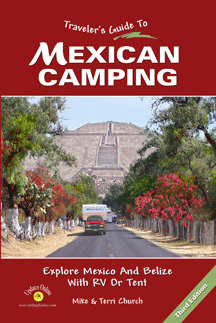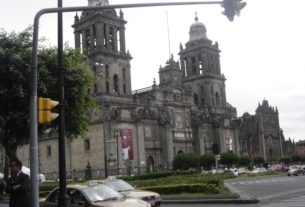Good Reading
 By Mike and Terri Church
By Mike and Terri Church
Rolling Homes Press, 2005
Available from Amazon Books: Paperback
This indispensable guide for campers exploring Mexico (and Belize) – using RV or tent – and now in its third edition is loaded with practical information.
Chapter 1, Why Camp Mexico?, lists some of the reasons to explore Mexico: the beaches – “Some of the best free camping you’ll ever see;” the interior – a superior climate and cultural attractions; off the beaten path – hiking in Copper Canyon or along “often impassable jungle tracks” in Chiapas; or the “Pre-Columbian Mesoamerican cities scattered throughout the country;” and of course “Mexico is well known as a shopping paradise, particularly for crafts.” Mexico is easy to visit, it is inexpensive, it has all the services you need, it has good roads that “get better each year,” it has wonderful weather, and it is safe and politically stable.
Also in this chapter, the authors of Traveler’s Guide to Mexican Camping, Mike and Terri Church, offer several possible itineraries. For example, Down the West Coast (24 days)… crossing at Nogales and taking Mex 15, you can take “a reasonably priced four-lane toll road almost all the way to Mazatlán.” This itinerary gives you “a taste of Mexico with little in the way of inconvenience” and includes overnights in places like Bahía Kino, Guaymas, Alamos, Mazatlán, San Blas, and Puerto Vallarta.
Other extensive itineraries include the Grand Coastal Tour (also Chiapas and Oaxaca) (45 days), which crosses into Mexico at Brownsville and initially takes you down the east coast, then across the southern tip of Mexico (including the ruins at Palenque), and to San Cristóbal de las Casas and to Oaxaca before heading north up the Pacific Coast, crossing back into the states at Nogales. This 4,600 mile (7,500 km) trip is “suitable for carefully driven large rigs. Each of the destinations chosen has at least one campground with sites large enough for 40-footers.”
Shorter trips include Colonial Mexico (27 days); The Northwest Interior – The State of Chihuahua (12 days); and The Baja Peninsula (17 days).
Chapter 2, Details, Details, Details tells you exactly what you need to do before you leave, and how much you can expect to pay (the Churches averaged $13.53 US per night in their 2004/2005 trip in a pickup camper (23 feet long), “never staying long enough for a discount.”
You will also discover that the best campgrounds “tend to be in popular areas of the Baja Peninsula and the west coast.” Should you prefer to travel with others of like mind, there are “about 200 caravans into Mexico each year.” Typically a caravan “is composed of approximately 20 rigs” and the price includes “a knowledgeable caravan leader in his own RV, a tail-gunner or caboose RV with an experienced mechanic, campground fees, many meals and tours at stops along the way, and lots of camaraderie.” Mike and Terry list the addresses and phone numbers of ten “leading caravan companies.” What about money? Drinking water? Vegetables? Children? Driving in Mexico? Gas stations? Insects? Insurance? Laundry? Police? Telephones? Toll Roads? Vehicle Preparation and Breakdowns? These are all some of the sub-sections of Chapter 2.
Chapter 3, Crossing the Border tells you what documentation you need to enter Mexico, and this includes for people vehicles, and pets. You will also find what you can take into Mexico and what you cannot (guns, for example, can get you a term in a Mexican jail). You will also find a detailed discussion of each of the more popular border crossings. “Nogales is the preferred crossing for folks headed down Mexico’s west coast since it is serviced by the U.S. Interstate Highway 17 from Tucson to the north and serves as the beginning of Mex 15….” With each border crossing, you can also read about campgrounds in the U.S., immediately north of the crossings.
The chapters that soon follow are the bulk of the book – the “Destination Chapters” – and these are organized geographically. Preceding these detailed listings of more than 400 campgrounds is Chapter 4, How to Use the Destination Chapters. Here are the keys to the legends used on the maps and keys to the symbols used in the individual campground descriptions so that you know in every case whether big rigs are accepted, or whether credit cards are accepted, whether pets are accepted, or whether there is electricity, water, a dump, a laundry, or hot or only cold showers.
The rest (and most) of the book is a detailed listing of Mexican campsites, most with full hookups-water, electricity, dump-organized by geographical areas.
- Chapter 5, The Northern West Coast: Nogales to Teacapán
- Chapter 6, The Central West Coast: San Blas to Acapulco
- Chapter 7, The Interior of Mexico
- Chapter 8, The East or Gulf Coast
- Chapter 9, Chiapas and Oaxaca
- Chapter 10, The Yucatán Peninsula
- Chapter 11, The Northern Gulf of California
- Chapter 12, Northern Baja Peninsula
- Chapter 13, Southern Baja Peninsula
- Chapter 14, Belize
I have only a couple of tents, but I would to take a low-budget trip to the Oaxaca Coast, to Bahías de Huatulco, Puerto Angel, and Puerto Escondido. Traveler’s Guide to Mexican Camping gives me a map, “The Oaxaca Coast,” where I discover Club de Playa Tangolunda, open all year, at Bahías de Huatulco. It has “a water faucet, a dump station, and a set of good restrooms with flush toilets and cold showers,” and the beach is just a “short walk through the trees.” The price is $5-$10 USD. Or Puerto Angel, a “small, sleepy fishing village,” where you can camp on Zipolite Beach, although large rigs should go to Fernando’s La Palmera Trailer Park, “one of the better places to stay along the Oaxaca coast.” Puerto Escondido is the “most mature of the Oaxaca Coast resort towns,” and Mike and Terri offer three suggestions for campgrounds there.
I’ve also thought about a trip to Palenque, and there are seven detailed listings for campgrounds near this “not-to-be-missed” archeological site. Mayabell Campground sounds nice, priced between $10 and $15 a night, and that includes hot showers, water, electricity, and dump, as well as a restaurant. It is “the place to stay at Palenque, not because the facilities are great but because of the location.” It is on the edge of an “undeveloped forest,” and at night “campers are almost always serenaded by howler monkeys….” Tent campers like Mayabell Campground because the upper part “has lots of palapas suitable for hanging hammocks.”
The extensive and detailed listings in Traveler’s Guide to Mexican Camping are followed by an Appendix of road signs, dozens and dozens of them to help you avoid unnecessary difficulties. For example:
- CAMINO SINUOSO is “Winding Road”
- DESVIACION A 500 MTS is “Detour in 500 Meters”
- TOPES A 100m is “Speed Bumps 100 Meters Ahead”
- PRECAUCION CRUCE DE PEATONES is “Caution Pedestrian Crossing”
- CURVA PELIGROSA A 400m is “Dangerous Curve 400 Meters Ahead”
Whether you have a big rig or a little rig, just a pickup with a camper top or, like me, just a couple of tents, Traveler’s Guide to Mexico is one of the books to have to carry with you on your Mexican adventures!


Are the details still valid ten years later? Thanks
David, Many of the details have, inevitably, changed since the book was first published, especially in light of current security and Covid-19 concerns. For up-to-date information, you would be best served by posting specific questions on one of the very large Facebook groups about Mexico, such as “On The Road in Mexico.” TB